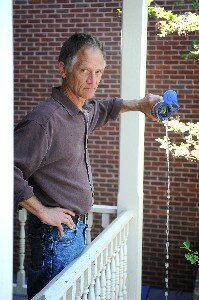Myers' watch: Don't heat the plastic

Pete Myers
PHOTO BY JEN FARIELLO
Now that Canada has branded them dangerous, the hazards lurking in Nalgene and baby bottles are all over the news, but they're nothing new to White Hall resident Pete Myers, who warned about such endocrine disruptors way back in 1996 in a book he co-wrote called Our Stolen Future.
Myers' top three suggestions for avoiding bisphenol A? 1) Don't microwave in plastic; 2) Minimize the canned food you eat; 3) Don't chew on thermal paper.
The latter is from receipts, and if recycled, they contaminate everything, according to Myers. "That's just now coming to light," he says. "Pizza probably has BPA from the cardboard box."
Myers, 58, first became aware that some plastics (and other common modern-life materials) can turn our hormones upside down in the early '70s, when he was working on his Ph.D. in biological sciences at Berkeley. He came to Charlottesville in 1990 to head the now-dismantled W. Alton Jones Foundation, and currently heads Environmental Health Sciences, a non-profit which compiles daily news about environmental health issues.
How bad is exposure to bisphenol A? "I think it's pretty serious," he says. "The levels in all Americans are above levels found to cause harm in animals."
He explains the BPA paradox. Studies done in the 1980s at high-dose levels of 50 parts per million resulted in dramatic weight loss in laboratory animals, and it was assumed– "not tested," stresses Myers– that much lower levels of 50 parts per billion were safe. It turns out that it's the lower levels that mimic estrogen, and have been linked to diabetes and obesity, "the biggest problems in public health right now," he says.
An accomplished Power Pointer, thanks to the 30-plus lectures he does a year, Myers illustrates the effect with a picture of two white mice, one of which is extraordinarily obese. The two are the same mouse strain, were fed the same number of calories, and did the same activities. The only difference is that the fat mouse was exposed to 1 ppb– one part per billion– of a synthetic estrogen similar to BPA, which "seems to convert stem cells into fat cells," he says.
When not traveling, "If it's above 48 degrees and not raining, I work from a platform in the woods," he says. He rises before dawn to aggregate the day's environmental health news with 50 other editors from around the world.
"I think he's doing a wonderful job informing the public of climate change and toxic substances in our environment," says Jason Halbert, an environmentalist who worked with Myers at W. Alton Jones.
U of MO's Fred vom Saal, who's led the charge against endocrine disruptors, praises Myers' Environmental Health News website's aggregation of scientific articles. "He created something incredible that everyone I know, whether scientists or journalists, uses to verify information. This is not PR."
All is not aggregation on his White Hall platform. Myers has captured some birds and wildlife up close, which resulted in his first photography shows– "Uncommon Views"– in March at Mudhouse and in Vermont.
(And while Myers hasn't seen the alleged Crozet cougar himself, he says he's spoken to two eyewitnesses he finds credible.)
A visitor to the Environmental Health Sciences offices is surprised to see plastic soft drink bottles in the recycling bin. "I drink out of plastic bottles," says Myers. "If you can squeeze them and they can crinkle, they're okay... we think."
A large green glass casserole sits atop the fridge, and Myers suggests eBay as a good source for microwavable glass. "Heat and plastic are a bad idea," he reminds.
Myers is headed out of town later to testify before a Senate committee in Washington.
An environmental health scientist's work is never done.
#